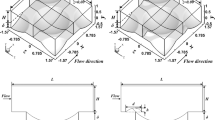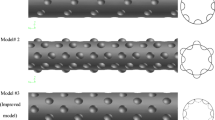Abstract
The effects of surface roughness on the hydro-thermal performance of laminar mixed convection heat transfer of water have been investigated numerically. The geometry was a semicircular curved horizontal dimples tube with a fixed dimensionless radius of curvature (2R/D = 6.62) and dimensionless roughness height of e/D = 0.1. Under low values of Re (100,200,400) and Gr numbers (20,000.100000,400,000), a constant heat flux was imposed on the tube walls. The three-dimensional governing equations were discretized, using a finite volume method. Dimensionless temperature, convective heat transfer coefficient, axial dimensionless velocity contours, secondary flow vectors, and surface friction coefficient are presented and discussed. The results showed that for identical conditions, the dimpled tube has better thermal performance compared to a smooth tube, especially in low Re values. So that in the low Re values, the dimpled tube has 58.2% higher heat transfer coefficient in comparison with the smooth ones. However, this predominance in thermal characteristics is mitigated by increasing Re number. Additionally, it has been shown that the skin friction coefficient of a curved dimpled tube is less than that of a smooth one in low Reynolds values. Using Colburn j factor and friction coefficient (f), and presenting j/f versus Re shows that the dimpled tube is more efficient at Re < 200.







Similar content being viewed by others

Abbreviations
- C f :
-
Skin friction factor
- D :
-
Tube diameter (m)
- e :
-
Roughness height (m)
- E :
-
Total energy (J/kg)
- f :
-
Darcy-Weisbachfriction factor
- g :
-
Gravitational constant (9.81m/s2)
- h :
-
Heat transfer coefficient
- j :
-
Colburn J factor
- k :
-
Thermal conductivity (W/m K)
- L :
-
Tube length (m)
- P :
-
Pressure (Pa)
- q " :
-
Uniform heat flux (W/m2)
- r :
-
Radial direction
- R :
-
Curvature radius (m)
- T :
-
Temperature (K)
- V :
-
Velocity (m/s)
- \( \overrightarrow{V} \) :
-
Velocity vector (m/s)
- z :
-
Axial direction
- n:
-
New
- w:
-
Tube wall
- 0:
-
Inlet
- θ :
-
Angular coordinate
- ρ :
-
Density (kg/m3)
- μ :
-
Dynamic viscosity (N s /m2)
- τ :
-
Shear stress (Pa)
- De n :
-
New Dean number Den = Re(D/2R)
- Gr :
-
Grashof number Gr = gβq"D4/kν2
- Nu :
-
Nusselt number Nu = hD/k
- Re :
-
Reynolds number Re = ρVD/μ
References
Bergles AE (1998) Handbook of heat transfer, 3rd edn. McGraw-Hill, New York
Bilen K, Cetin M, Gul H, Balta T (2009) The investigation of groove geometry effect on heat transfer for internally grooved tubes. Appl Therm Eng 29:753–761
Chen Y, Chew YT, Khoo BC (2013) Heat transfer and flow structure in turbulent channel flow over protrusions. Int J Heat Mass Transf 66:177–191
Kumar P, Kumar A, Chamoli S, Kumar M (2016) Experimental Investigation of Heat Transfer Enhancement and Fluid Flow Characteristics in a Protruded Surface Heat Exchanger Tube. Exp Thermal Fluid Sci 71:42–51
Vicente G, Garcia AG, Viedma A (2002) Heat Transfer and pressure drop for low Reynolds turbulent flow in helically dimpled tubes. Int J Heat Mass Transf 45:543–553
Sonraki k KR (2001) Condensation of R-134a inside dimpled helically coiled tube-in-shell type heat exchanger. Appl Therm Eng 129:535–548
Nivesrangsan P, Pethkool S, Nanan K, Pimsarn R, Fuller KG (2010) Thermal performance assessment of turbulent flow through dimpled tubes. Proceedings of the 14th International Heat Transfer Conference IHTC14, pp. 1-8
Kukulka DJ, Smith R, Fuller KG (2012) Development and evaluation of vipertex enhanced heat transfer tubes for use in fouling conditions. Theor Found Chem Eng 46:27–633
Kukulka DJ, Smith R (2013) Thermal-hydraulic performance of vipertex 1EHT enhanced heat transfer tubes. Appl Therm Eng 61:60–66
Kukulka DJ, Smith R (2017) Comparison of condensation and evaporation heat transfer on the outside of smooth and enhanced 1EHT tubes. Appl Therm Eng 105:917–922
Mashayekhi M (2014) Numerical study of effect of roughness on the turbulent convective heat transfer of a nanofluid, Master thesis, University of Sistan and Baluchestan
Ming T, Cai C, Yang W, Gan T (2018) Optimization of Dimples in Microchannel Heat Sink with Impinging Jets — Part A: Mathematical Model and the Influence of Dimple Radius. J Therm Sci 27:195–202
Shui L, Sun J, Gao F, Zhang C (2018) Flow and Heat Transfer in the Tree-Like Branching Microchannel with/without Dimples. Entropy 20:379
Sobhani M, Behzadmehr A (2018) Investigation of thermo-fluid behavior of mixed convection heat transfer of different dimples-protrusions wall patterns to heat transfer enhancement. Heat Mass Transf 54:3219–3229
Goering DJ, Humphrey JAC, Greif R (1997) The dual influence of curvature and buoyancy in fully developed tube flows. Int J Heat Mass Transf 40:2187–2199
Wael AI (2014) Numerical study on turbulent heat transfer and pressure drop of nanofluid in coiled tube-in-tube heat exchangers. Energy Convers Manag 79:304–316
Chimres N, Wang CC, Wongwises S (2018) Optimal design of the semi-dimple vortex generator in the fin and tube heat exchanger. Int J Heat Mass Transf 120:1173–1186
Li LJ, Lin CX, Ebadian MA (1998) Turbulent mixed convection heat transfer in the entrance region of a curved pipe with uniform wall-temperature. Int J Heat Mass Transf 41:3793–3805
Akbarinia A, Behzadmehr A (2007) Numerical Study of Laminar Mixed Convection of a Nanofluid in a Horizontal Curved Tube. Appl Therm Eng 27:566–586
Ghaffari O, Behzadmehr A, Ajam H (2010) Turbulent mixed convection of a nanofluid in a horizontal curved tube using a two-phase approach. International Communication in Heat and Mass Transfer 37:1551–1558
Alikhani S, Behzadmehr A, Saffar-avval M (2011) Numerical study of nanofluid mixed convection in a horizontal curved tube using two-phase approach. Int J Heat Mass Transf 47:107–118
Huminic G, Huminic A (2016) Heat transfer and flow characteristics of conventional fluids and nanofluids in curved tubes. Renew Sust Energ Rev 58:1327–1347
Wojtkowiak J, Popiel CO (2000) Effect of cooling on pressure losses on U-type wavy pipe flow. International Communication in Heat and Mass Transfer 27:169–177
Author information
Authors and Affiliations
Corresponding author
Ethics declarations
Conflict of interest
There is no conflict of interest.
Additional information
Publisher’s Note
Springer Nature remains neutral with regard to jurisdictional claims in published maps and institutional affiliations.
Highlights
• Numerical study of a laminar mixed convection inside a curved dimpled tube.
• Heat transfer coefficient of a curved dimpled tube is more than that of a smooth one.
• Skin friction coefficient of a curved dimple tube, in low Reynolds number, is negligible.
• Using dimple tubes in the low Reynolds numbers are more beneficial.
Rights and permissions
About this article
Cite this article
Ganjbakhsh, N., Alikhani, S. & Behzadmehr, A. Numerical study of the effects of surface roughness on the mixed convection heat transfer of a laminar flow inside a horizontal curved dimpled tube. Heat Mass Transfer 55, 2009–2016 (2019). https://doi.org/10.1007/s00231-018-2502-4
Received:
Accepted:
Published:
Issue Date:
DOI: https://doi.org/10.1007/s00231-018-2502-4



